For a distinctive flowering perennial plant that will bring some unique textures to your garden, try planting lamb’s ear.
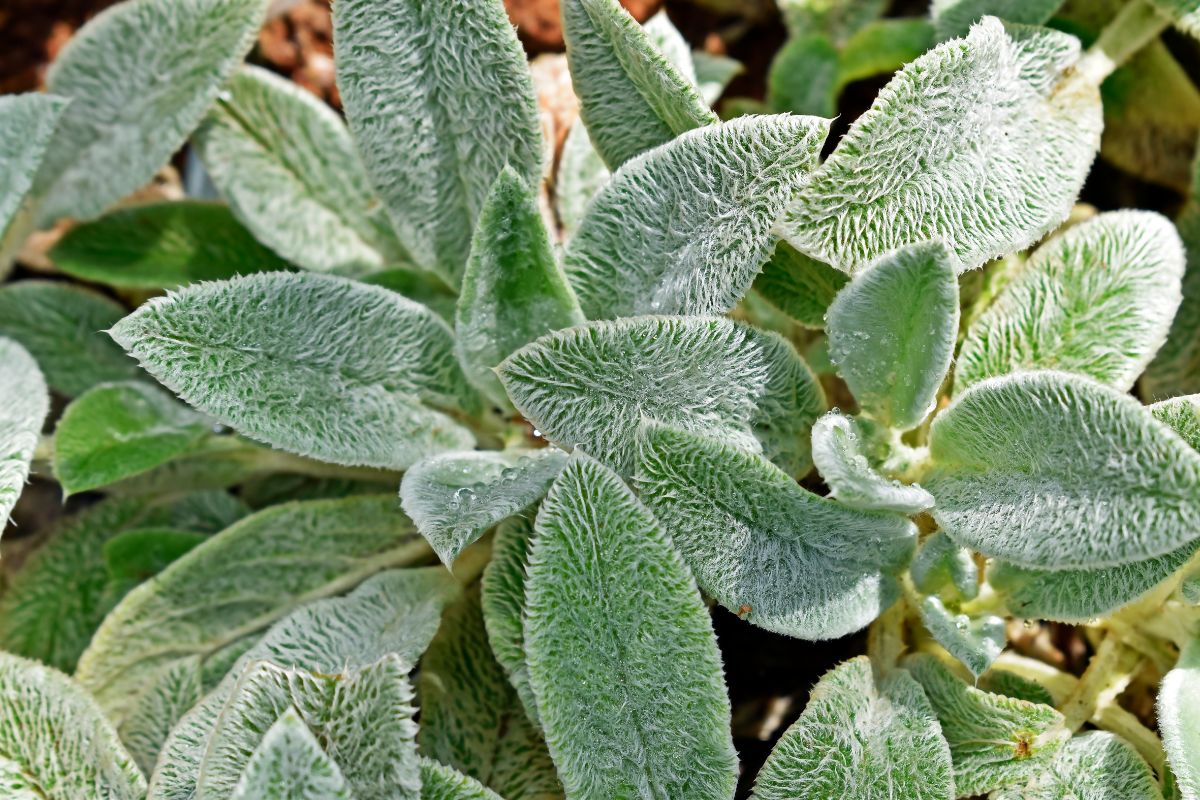
Lamb’s ear can be easy even for novice gardeners to grow with the help of our lamb’s ear growing guide. Jump to any section using the advanced jump below, or read on for the full guide.
Jump to:
- What Are Lamb’s Ears?
- Lamb’s Ear Basics
- Where Do Lamb’s Ears Grow?
- Why Grow Lamb’s Ears?
- When Do Lamb’s Ears Bloom?
- How Long Do Lamb’s Ears Bloom?
- When to Plant Lamb’s Ears
- Ideal Growing Conditions for Lamb’s Ears
- How to Plant Lamb’s Ears
- How to Propagate Lamb’s Ears
- How to Care for Lamb’s Ears
- Recommended Planting Combinations for Lamb’s Ear
- Lamb’s Ear Landscaping Ideas
- Recommended Lamb’s Ear Varieties
- Frequently Asked Questions About Growing Lamb’s Ears
- Where to Buy Lamb’s Ears
What Are Lamb’s Ears?
Lamb’s ear is the common name for the plant Stachys byzantina. It can also be spelled with a hyphen: lamb’s-ear. Another less common name for it is “woolly hedgenettle.” It also sometimes is referred to as “betony.”
While some people use the term “lamb’s ear” to refer strictly to Stachys byzantina, it may also sometimes be used to refer to other plants that are part of the Stachys genus.
Many people believe that lamb’s ear is a type of sage, but it is not. Sage and lamb’s ear both belong to the mint family, however, so they are related.
The name “lamb’s ear” refers to the texture of the leaves as well as their curved shape. With the whitish-silvery hair that grows on them, they bear a vague resemblance to the ears of a lamb.
In case you are wondering, yes, you can touch the leaves, and yes, they do feel as soft and fuzzy as they appear.
The soft texture of the leaves as well as their silvery color, makes them stand out from surrounding plants. They also produce spikes of purplish blooms that are attractive to bees and other pollinators.
Lamb’s Ear Basics
| Zones: | 4-8 |
| Blooming season: | Spring and summer |
| Expected height: | Up to 18 inches |
| Soil: | Well-drained soil |
| Sun: | Full to partial |
Where Do Lamb’s Ears Grow?
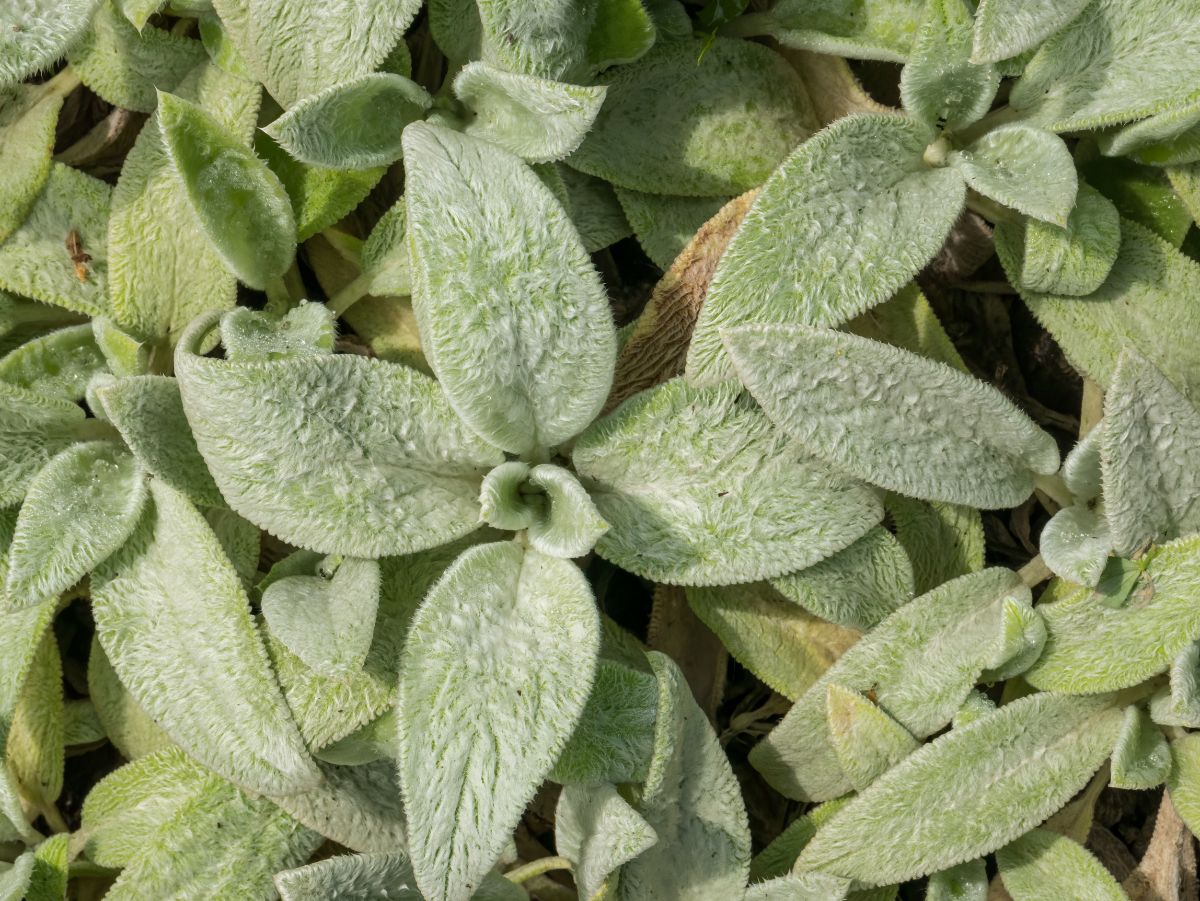
Lamb’s ear plants are native to the Mediterranean area. Because they grow in a wide range of climate zones, you can now find them on many continents.
Why Grow Lamb’s Ears?
There are so many excellent reasons to consider growing lamb’s ears in your garden. Here is what makes lamb’s ears awesome:
● Lamb’s ears are so easy to grow. University of Wisconsin-Madison Extension Dodge County refers to a study by the Chicago Botanical Garden that concluded “Lamb’s ears … are stalwart perennials with outstanding ornamental features for a variety of gardens.” The plant’s needs are minimal with respect to fertilizing, pruning, and other forms of maintenance.
● The fuzzy leaves have the most amazing texture and appearance. You will love the contrast the silvery foliage brings to your garden and will enjoy running your hands over the soft leaves as you stroll through your flower beds.
● Pest problems are not a big issue with lamb’s ear plants. This is thanks in part to the texture of the leaves.
● While pests will avoid lamb’s ear, friendly visitors to your garden will be attracted to the flowers. Get ready to welcome hummingbirds, bees and butterflies aplenty.
● This plant is generally evergreen. The only exception is if you get really harsh winters.
● Lamb’s ear is a drought-tolerant plant that will be happy even in dry climates.
● Do you have children? If so, the lamb’s ears plants are guaranteed to be a hit with them. Kids can’t get enough of their fuzzy texture, so they are great for sensory play.
● This plant can tolerate a range of soil types. That includes poor soils, rocky soils and dry soils that other plants may not like. So, you can plant lamb’s ears to fill out spots in your garden that right now are empty eyesores.
When Do Lamb’s Ears Bloom?
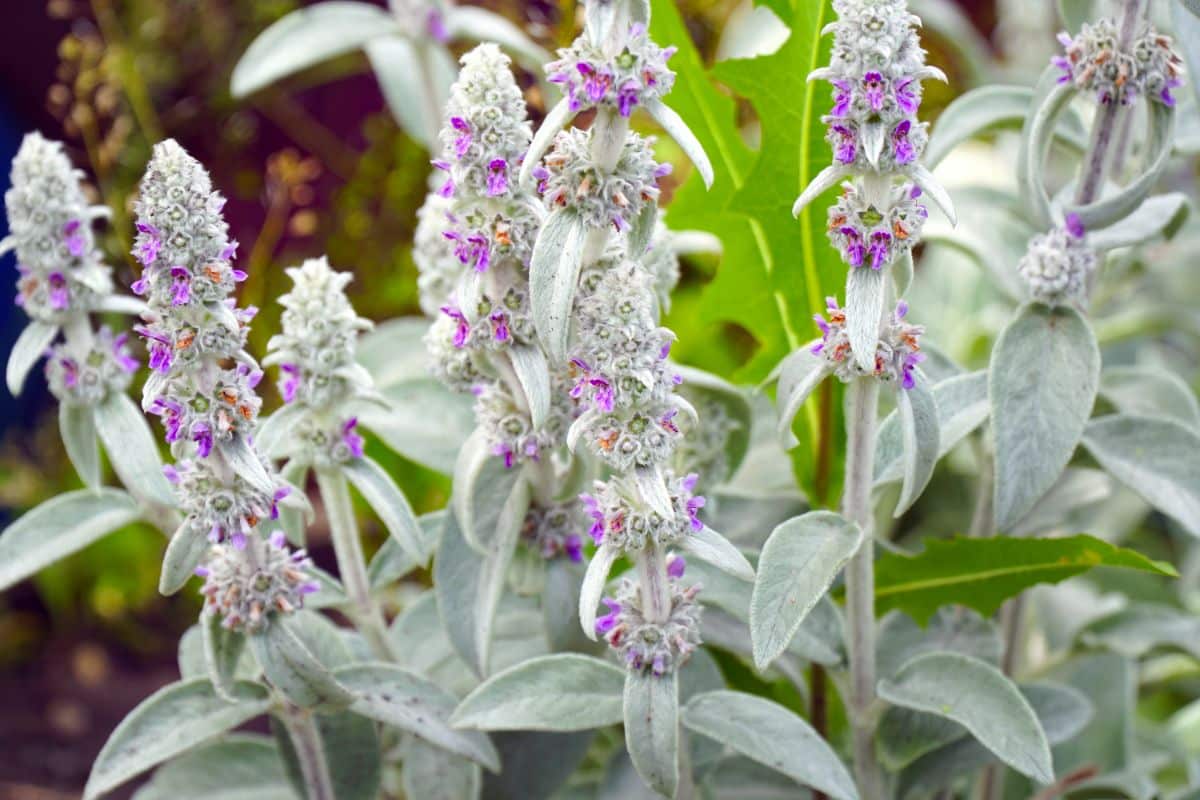
Lamb’s ears have a spring and summer bloom period.
How Long Do Lamb’s Ears Bloom?
The bloom time for a lamb’s ears can last for a few weeks. You can get additional blooms by deadheading.
When to Plant Lamb’s Ears
The best time to plant lamb’s ear in your garden is spring after the last frost.
Ideal Growing Conditions for Lamb’s Ears
Let’s talk about how you can ensure that your lamb’s ear stays healthy through proper soil conditions, watering, and sun exposure.
How Much Sun Do Lamb’s Ears Need?
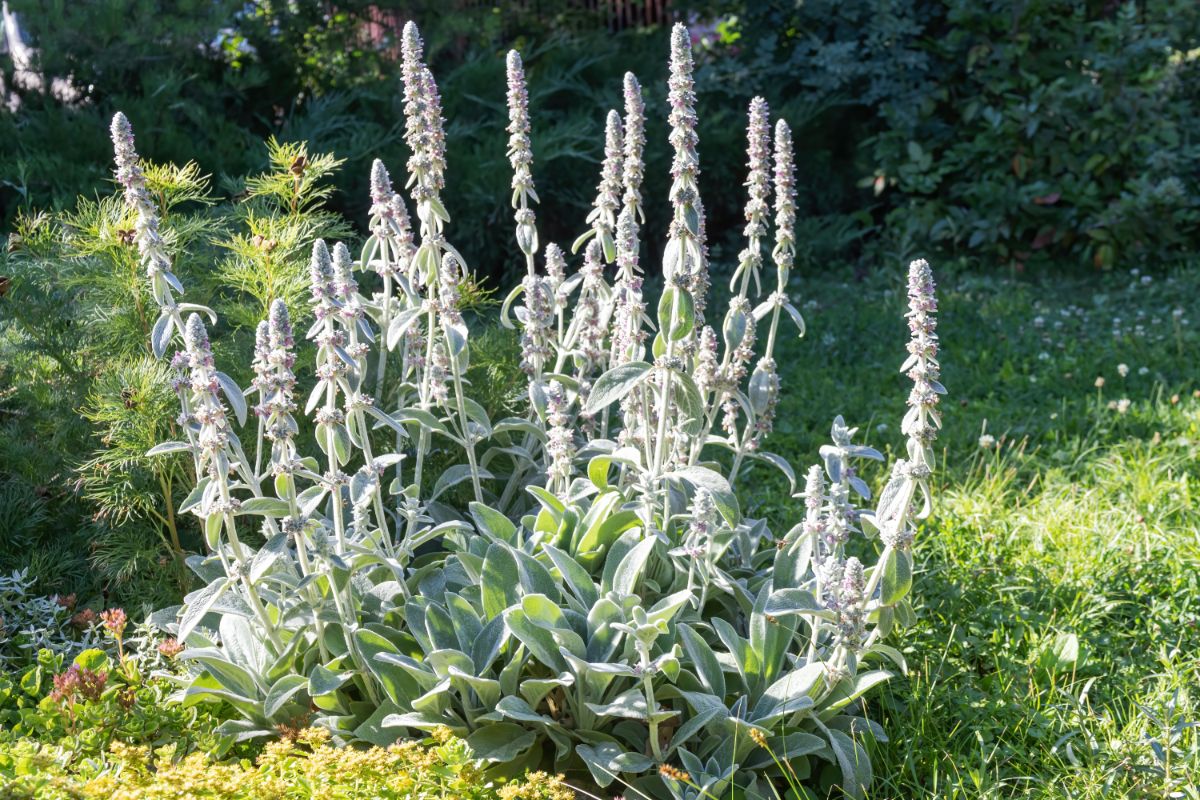
Like many other plants in your garden, lamb’s ear requires 6-8 hours of sunlight per day. Full sun is best, but you can also plant lamb’s ear in partial shade so long as it is still receiving the ample sunlight it needs.
One thing to be aware of if you are planning on planting it in partial shade is that the leaves are often less fuzzy if they are exposed to less sun.
So, if you want to maximize the beautiful texture of the foliage, you definitely are going to want to choose a sunny spot.
There is one situation, however, where your plant may be healthier in partial shade, and that is if you have a hot climate with an intense sun that may burn the leaves. Afternoon shade will provide the plant with valuable protection.
What Type of Soil is Right for Lamb’s Ears?
Average, well-draining soil is best for a lamb’s ear. While you can plant them in poor soil (including rocky soil), you should avoid planting them in rich soil. Moist soils are okay if they drain well, and dry soils are also fine.
Compost can help improve the drainage of soils so that they will not hold in too much moisture and heighten the risk of rot. While light compost provides some nourishment to the plant, it will not overly enrich the soil the way that liquid fertilizers might.
As for the pH of the soil, slightly alkaline, neutral, or slightly acidic are all fine.
How Much Water Do Lamb’s Ears Need?
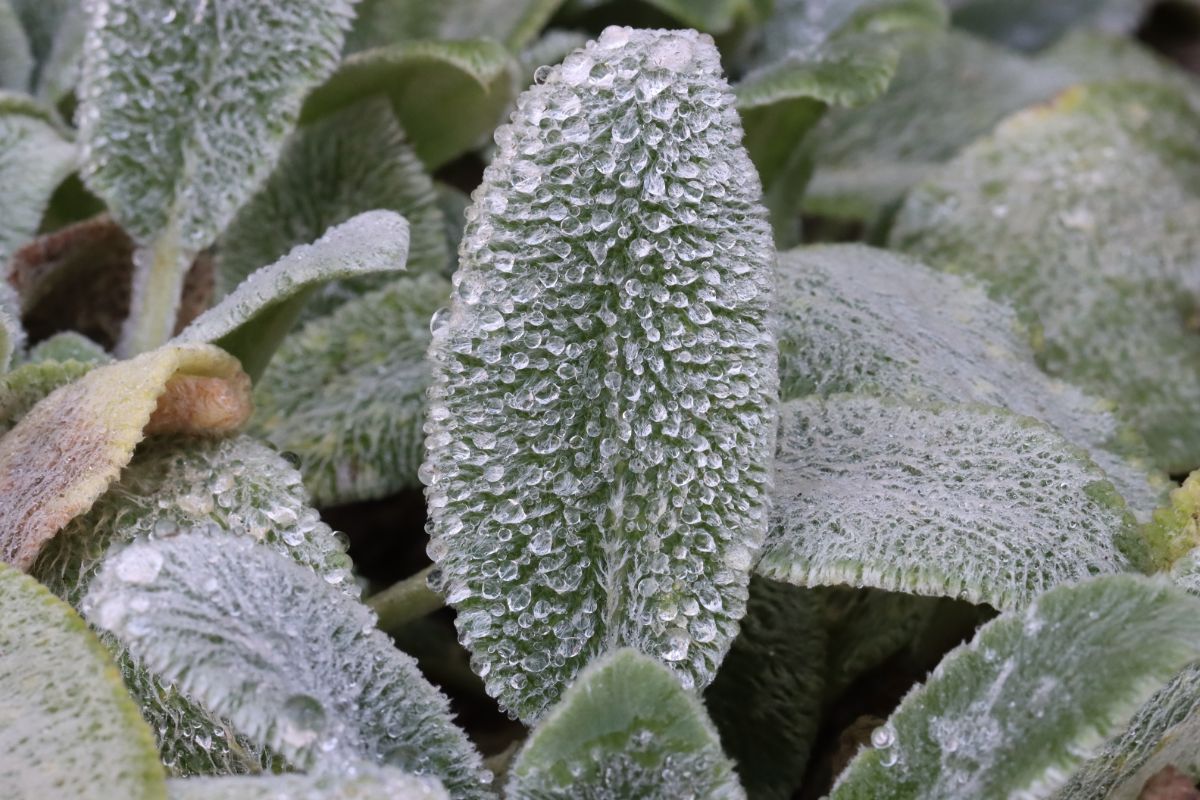
About an inch of weekly water is plenty for lamb’s ear. Your lamb’s ears’ water needs will often be taken care of sufficiently from precipitation, but during dry spells, you will need to water them yourself. When you do, water from the bottom if you can, taking care to avoid getting water on the leaves. This will help you to prevent rot.
Note that during the months after you plant a lamb’s ear, it will need some extra water to establish. Also, if you have your lamb’s ear plants in pots, they will dry out more quickly than your garden beds. So they might need a little more water.
How to Plant Lamb’s Ears
Generally, when you plant lamb’s ears, you will use a starter plant from a nursery, though it is possible to propagate the plant successfully in your garden from seeds if you are patient.
We will go over instructions for ground and container planting using a nursery plant and then discuss instructions for starting from seeds.
Ground Planting

Here are the steps to planting lamb’s ear in your garden beds:
1. Pick a location for a lamb’s ear that has suitable sun and soil conditions.
2. Prepare the soil. The only amendment you need to add is compost.
3. Dig holes for your lamb’s ear plants. Put each plant at least a foot away from those around it. Some gardeners prefer spacing of 2-3 feet.
4. Backfill the soil and water well.
After you have planted lamb’s ear, it will need some extra water while it establishes, just as many other types of perennials do.
Container Planting

Most gardeners prefer to plant lamb’s ear directly in their flower beds. But it is possible to grow it in a large container. Here is how you can do it:
1. Choose a container that has a three-gallon capacity. Make sure it has excellent drainage.
2. Fill your container will potting mix that also drains effectively.
3. When you have filled about half of the pot, remove your lamb’s ear plant from the nursery container and transfer it to the new container.
4. Fill in the rest of the potting mix.
5. Water well.
Be aware that even though you chose a large pot for your lamb’s ear, it is going to eventually need more room. So, in a few years’ time, you will need to remove it from the pot, divide it, and transplant the divisions.
How to Propagate Lamb’s Ears
Now that you know how to grow a lamb’s ear, it is time to learn how to propagate it. That said, you probably will not have to work too hard to get more lamb’s ear. This plant spreads like crazy.
Starting Lamb’s Ears from Seed
You should start your lamb’s ear seeds around 8 to 10 weeks before you expect the last frost of the year. Here is how you can start lamb’s ear from seed step-by-step:
1. Fill starter trays with drainage holes with seed starting mix.
2. Sow the seeds on top of the soil. Then, gently press them in. Make sure you do not cover them, though. You just want the soil to hold them in place.
3. Spray the potting mix with water so that it is moist, being careful not to dislodge the seeds (you can always spray right before sowing; this is sometimes easier).
4. Cover each tray with plastic wrap or a clear plastic lid. This will help keep the potting mix moist.
5. Wait for the lamb’s ear seeds to germinate. Check on them regularly and moisten the potting mix when needed. Consider setting them on a warming mat if it is not already sufficiently warm inside your home.
6. When the seedlings sprout, take off the cover. Keep moistening the potting mix when it gets dry, letting the seedlings further develop.
7. Harden the seedlings before planting outdoors. Hardening is a process that lets plants acclimate to living outdoors. You take them outside for short periods of time and then gradually increase the length of time spent outside each day. Eventually, they will adapt, and you can transplant them in your garden.
Starting Lamb’s Ears from Cuttings
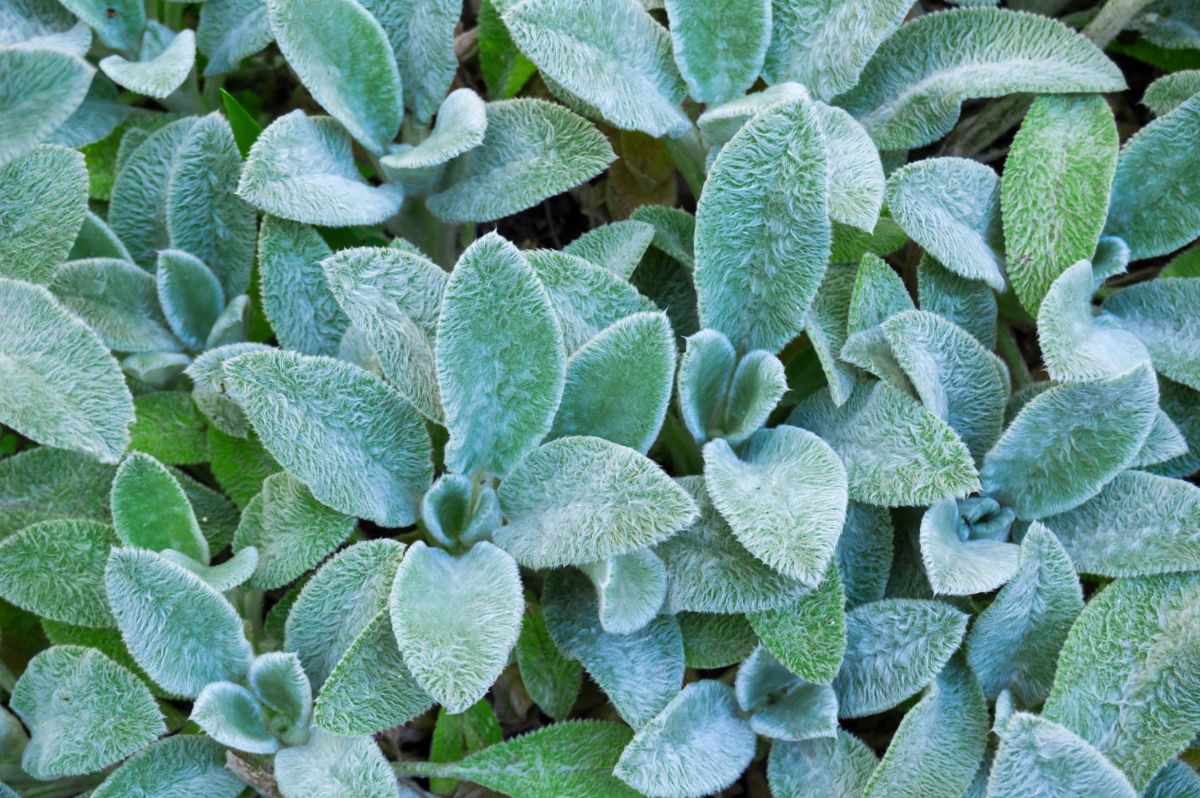
So far as we can tell, it is not possible to propagate lamb’s ears from cuttings. You will just need to stick with propagation from seeds or divisions.
How to Divide Lamb’s Ears
Do you see a hole forming in the middle of your lamb’s ears patch? If so, that means that it is time to divide. Here is how to do it.
1. In spring, use a shovel to dig in a circle around your lamb’s ear plant.
2. Push the shovel underneath the plant to pry it out of the ground.
3. Split the plant into two or more divisions as appropriate.
4. Dig holes for the newly divided plants and transplant them.
If you miss out on your early spring opportunity for dividing, you can take care of it in late summer once the growing season is largely over. That said, the plant is more likely to survive the division process if you take care of it in early spring.
We have also seen some gardeners say that they skip digging in a circle around the plant and pulling the whole thing out of the ground. Instead, they just push their shovel right down into the middle of the lamb’s ear clump and then pry out a part of it to move. Use whichever method works best for you.
How to Care for Lamb’s Ears
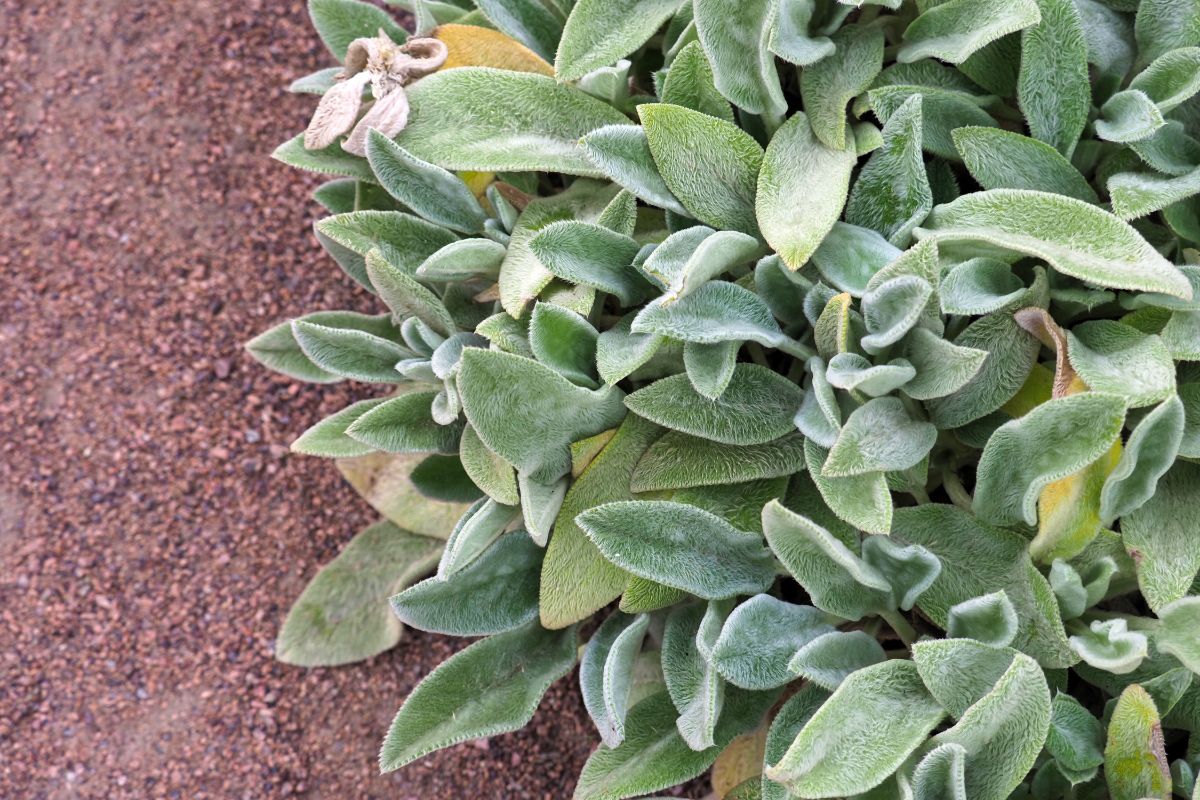
How do you take care of this plant with its fuzzy, silvery-green leaves once it is in your garden? Let’s discuss recommendations for fertilizing, mulching, and more.
How to Fertilize Lamb’s Ears
A bit of compost is good for a lamb’s ear. But beyond that, no additional fertilizer is recommended. Lamb’s ear soil should not be overly rich.
How to Mulch Lamb’s Ears
It is suggested that you mulch around your lamb’s ear plants. The main purpose of doing so is to help prevent leaf rot. Mulching also can keep weeds away from the lamb’s ear.
How to Stake Lamb’s Ears
Lamb’s ear stalks are pretty sturdy. So, they generally will not droop if you plant them in suitable conditions until late in the season. At that point, it generally makes sense to cut them back rather than stake them.
How to Prune Lamb’s Ears
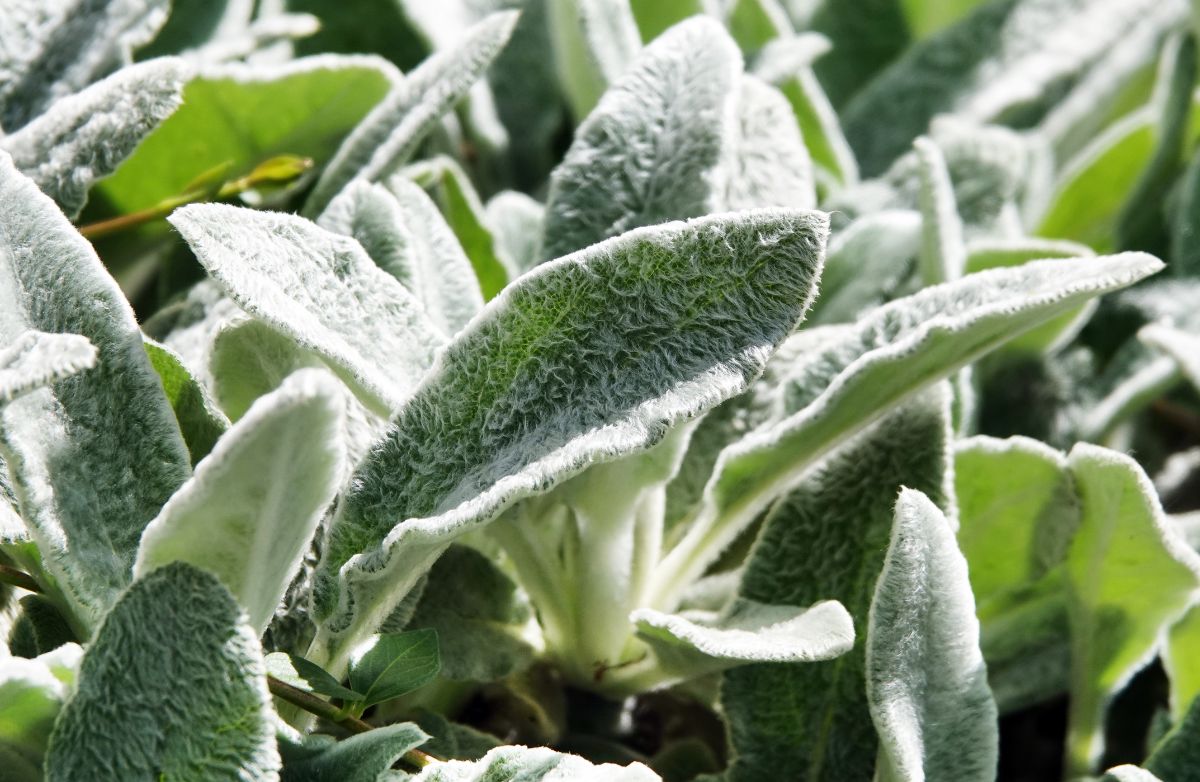
There are two steps involved in pruning lamb’s ears: deadheading them during the bloom season and cutting them back after they are done flowering for the year.
How to Deadhead Lamb’s Ears
It is generally considered a good idea to deadhead a lamb’s ears. Deadheading the spent blooms can sometimes result in another flush of blooms.
But more importantly, deadheading lamb’s ears will stop this aggressive spreader from going to seed, helping to keep it neatly contained.
That said, if you want it to spread, don’t deadhead it.
One more reason to deadhead lamb’s ears is simply to tidy it up. While the flower stalks are beautiful in bloom, they can have a messy appearance afterward. So, many people like to trim them just to improve the look of their garden.
When to Cut Back Lamb’s Ears
In the fall, you will notice the flower stalks becoming droopy. When that happens, you can trim them back for the year.
You do not have to trim the whole plant back. In many climates, lamb’s ears are evergreen, so you want to leave the leaves intact.
If you find some dead leaves while you are trimming away the stems, you can remove those. Otherwise, you should leave the plant alone for winter. Just keep enjoying its fuzzy foliage.
Are Lamb’s Ears Vulnerable to Diseases or Pests?
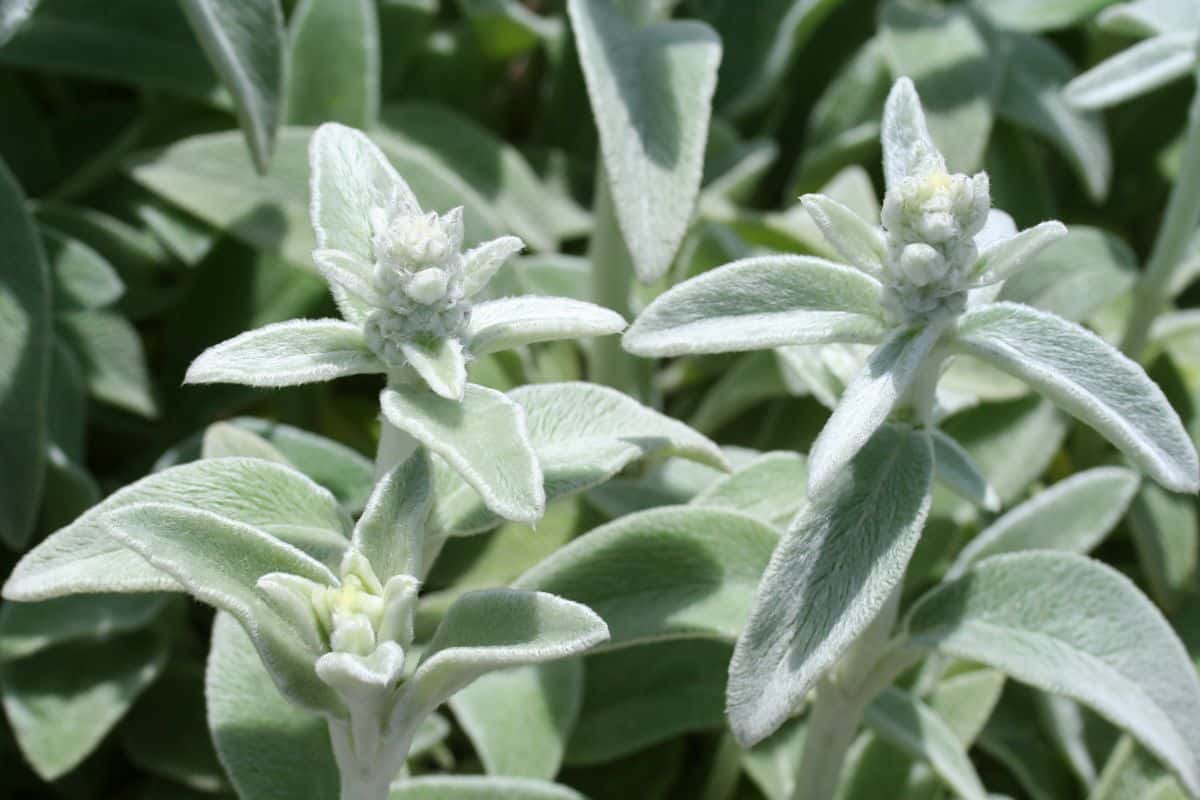
Leaf spots, powdery mildew, rust, and rot are all problems that can affect a lamb’s ear. Most of these issues can be mitigated by taking steps to make sure that your plant does not get too damp for too long.
Lamb’s ear is more likely to rot if you plant it in soggy soil that does not drain effectively. It can also suffer if it is being crowded by other plants (including other lamb’s ears). In humid conditions, it is extra important to ensure plenty of airflow. Being prompt to remove dead foliage can be a big help as well.
Although you can sometimes face an uphill battle against rot problems with lamb’s ears, you will be pleased to learn that pest problems are limited.
It seems that the fuzzy texture of the leaves is a deterrent to the majority of insect pests. Lamb’s ears can sometimes have problems with nematodes. Slugs and snails also can occasionally damage the plants. They also like to hide under the leaves, using lamb’s ear stands as a kind of “base” from which to attack other nearby plants.
For that reason, even if you do not notice any signs of slugs or snails damaging the lamb’s ears themselves, you should check under the plants from time to time to see if they are becoming a hideout for these garden pests.
What about mammals? Happily, deer and rabbits alike are unlikely to harass lamb’s ears.
Recommended Planting Combinations for Lamb’s Ear
Here are several popular companion plants for lamb’s ear:
● Sage: Not surprisingly, sage is frequently selected as a companion plant for lamb’s ear. The similar appearances of the plants delight the senses, and sage can grow in the same conditions as lamb’s ear. Russian sage is particularly popular as a companion plant option. See our Sage Full Growing Guide.
● Allium: These ornamental onion plants produce surreal-looking balls of blooms on top of tall stems. Interspersed among your lamb’s ears, they can add textural interest.
● The flat-topped flower clusters of yarrow plants are another favorite for bringing textural variety to a stand of lamb’s ears.
Lamb’s Ear Landscaping Ideas

How can you most effectively use lamb’s ear in your garden? Check out these landscaping recommendations:
● Rock garden: As an extremely drought-resistant plant that is tolerant of dry soil, lamb’s ear can thrive in a rock garden.
● Fill in a dry area: Have an ugly, barren patch in your garden where you cannot get other plants to grow because the soil is just too dry? Try planting lamb’s ear there. There is a good chance it will flourish, and you will no longer have to look at bare soil.
● Borders: One of the most popular ways to grow a lamb’s ear is as a border. You can use it to line a walkway, steps, sidewalk, etc., or as a border around your flower beds.
● Focal clusters: The clumped foliage of the lamb’s ear with the tall flower stalks protruding can attract the eye to the focal points you want to emphasize in your garden.
● Pollinator garden: Since bees, butterflies, and hummingbirds love lamb’s ear, it is a great plant to add to your pollinator garden.
● Groundcover: If you want a blanket of foliage to serve as a groundcover, lamb’s ear is an ideal choice. You can get it to spread rapidly with little effort.
● Contrast: The distinctive color and texture of the leaves of the lamb’s ear make it stand out from the more typical foliage around it. Use it to add contrast to your garden, offsetting plants with more traditional leaves.
Recommended Lamb’s Ear Varieties
There are multiple varieties of Stachys byzantina out there that can bring just the look you desire to your perennial garden. Below, we share some of the most popular types of Stachys byzantina with you as well as some other plants in the Stachys genus that can beautify your garden.
● Helen von Stein: This cultivar of Stachys byzantina lamb’s ear also goes by the name “Big Ears.” It can grow up to 18 inches tall and up to 24 inches wide. While it is possible for Big Ears to flower, it normally doesn’t. So, you will want to purchase it exclusively for foliage. It is an ideal option for a ground cover or a border plant. You also might consider it if you want to pick a variety of lamb’s ear that will not spread aggressively; the lack of flowering prevents it from going to seed.
● Silver Carpet: Like Helen von Stein, this is a cultivar of Stachys byzantina lamb’s ear that does not bloom or go to seed. As you would guess, given its name, it also makes for a nice ground cover.
● Pink Cotton: Looking for a Stachys plant that produces dramatic flower spikes with pink blooms? The Pink Cotton variety, Stachys lavandulifolius, will delight you. If you are living in a hot, dry climate, it is one of the best options you can pick. You will also want to note that it can grow well in clay soil so long as the clay is dry.
● Dwarf Pink: This name refers to Stachys maxima. It produces spikes with pink flowers in summer and maxes out at just half a foot tall. This makes it an excellent choice for a compact ground cover. You’ll be pleased to know that it is quite hardy and does a good job resisting weeds.
● Red Flowered: The majority of lamb’s ear plants that flower produce blooms that are pinkish or purplish. One exception is Red Flowered, which produces gorgeous bright red blooms. It also goes by the name “Mountain Red.” The trumpet-shaped blooms will be especially popular with hummingbirds. It is also a good option if you have a cold location.
● Wood Betony: Stachys officinalis is a type of lamb’s ear that is sometimes called “wood betony” or “bishop’s wort.” It can reach up to 2 feet in height and produces beautiful purplish-reddish blooms. Don’t be surprised if you see some bees buzzing around this perennial favorite.
● Rosea Wood Betony: This is just a variation on wood betony with blooms in pale pink during summer.
● Saharan Pink Betony: One more option to think about is the compact “Saharan Pink,” which is a name for the species Stachys monieri. The flowers are pink. “Hummelo” is another name for it.
● Big Betony: This name refers to Stachys macrantha. The spikes can reach up to 2 feet and produce purple blooms. It is a fairly late bloomer, and you can continue to enjoy the blossoms into early autumn.
There are other types of lamb’s ears you can also buy for your garden. You will have the biggest selection of varieties if you look online for lamb’s ear rather than shopping at your local store.
If you are looking for a fast and easy way to compare different types of Stachys plants, you can check out the study from the Chicago Botanical Garden. On the second page, you will find a convenient chart that names the different varieties along with their flower colors, bloom periods, foliage colors, dimensions, and more. They have all been assigned overall ratings.
Study author Richard G. Hawke writes, “In general, Stachys proved to be exceptional perennials for Northern gardens. The majority of taxa received four-star good ratings, with only one taxon receiving poor marks. Stachys monieri ‘Hummelo’ received the highest rating in the trial based on strong flower production, plant health, habit quality, and winter hardiness. Stachys thirkei is not as adaptable to average garden conditions as S. byzantina, but has potential in Northern gardens when sharp winter drainage is provided.”
Frequently Asked Questions About Growing Lamb’s Ears
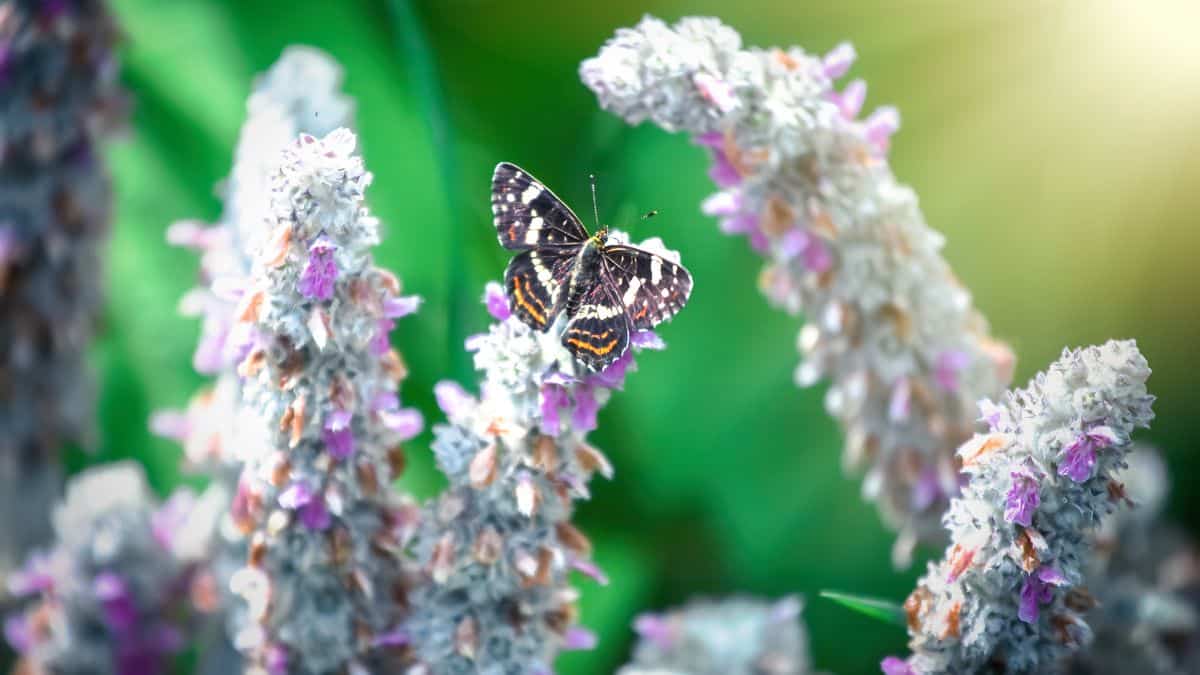
To wrap up our guide to lamb’s ear, let’s answer a few questions you might have about this fuzzy perennial.
If you find leaf damage that appears to be caused by a pest, slugs or snails are the most likely culprits.
Thankfully, most pests avoid eating lamb’s ears, so hopefully, you will not run into this issue too often.
No, lamb’s ear is not the same as sage. The scientific name for lamb’s ear is Stachys byzantina. Stachys is the genus. Sage, by contrast, refers to plants that are part of the Salvia genus.
Both lamb’s ear and sage are part of the mint family, Lamiaceae.
No, a lamb’s ear is not considered to be a poisonous plant. That said, it has been known to lead to an upset stomach if cats, dogs, or horses consume it. The same is true for humans who consume too much of it.
Another consideration is that animals trying to eat lamb’s ear could choke on the leaves trying to get them down. So, that is another reason to keep your pet from eating your lamb’s ear plants.
Lamb’s ear is indeed a fast-spreading plant. In some areas, it is considered to be invasive.
Lamb’s ear’s ability to spread is excellent if you are in search of a rapidly growing groundcover—but you should make sure it is not going to be a problem in your area before you plant it.
If it is not invasive in your area and you do decide to plant it, you still may want to take precautions to prevent it from taking over your garden.
Lamb’s ear is astringent and also helps to fight bacteria. For that reason, it can be used as a natural remedy for treating minor wounds. Some people also reportedly gargle it or swish it around as mouthwash. Keep in mind that lamb’s ear is not a replacement for prompt medical treatment of illnesses or injuries.
Lamb’s ear is considered to be an herbaceous perennial plant that flowers every year in zones 4-8.
Where to Buy Lamb’s Ears

If you want to bring these enchanting fuzzy plants to your garden, you can shop lamb’s ear varieties online. Click the link below to browse cultivars.

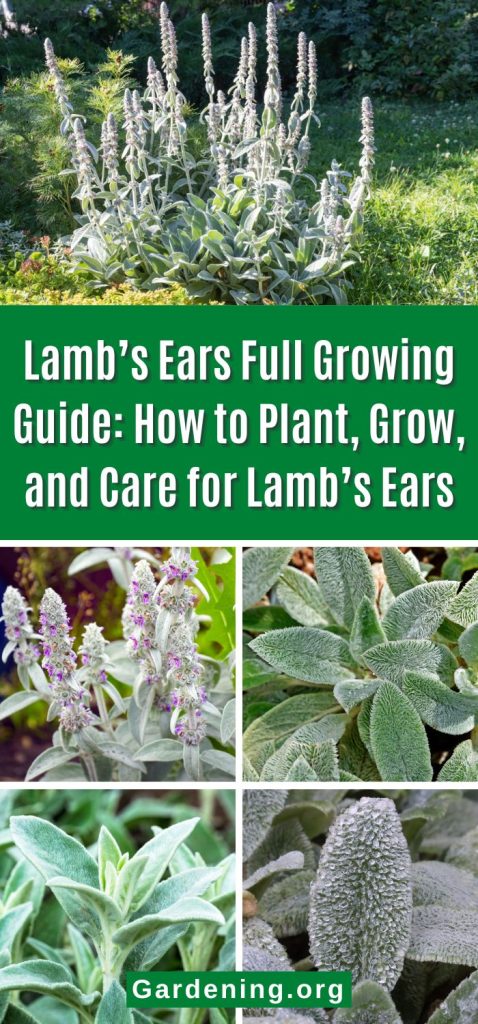

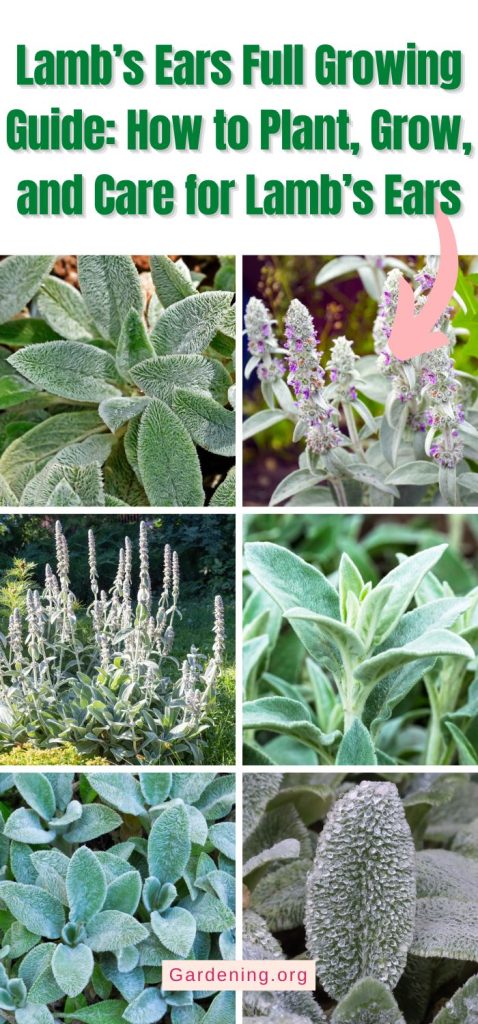

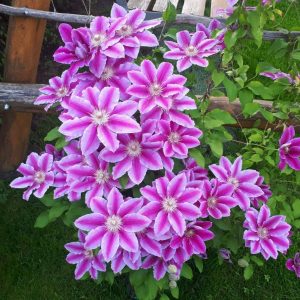
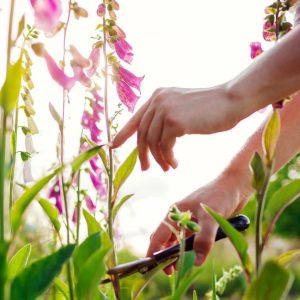
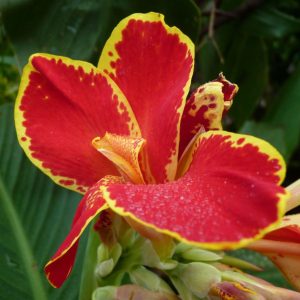
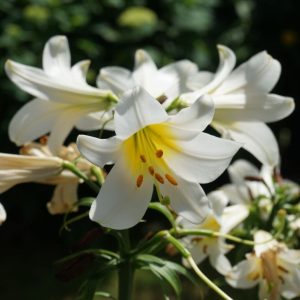
Leave a Reply